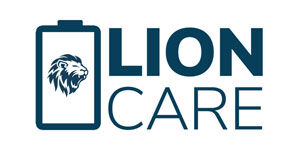incl. VAT.
Please note: Notes on delivery time
Free shipping (Germany, mainland)!
Shippingtime: 1-2 Wochen
- Article no: GENLOBSD1P

Questions about the article?
Our staff member Petra Fürbeck is happy to help you:
+49 (0) 7151 - 256 4817 or info@lion-care.com
| Dimensions: | 1400 x 1000 mm |
| Permeable to water?: | No |
| Suitable for: | Small appliances and rechargeable batteries |
| Heat resistance (permanent): | 1000° C |
| Weight: | 6 kg |
Please note that the terms "fire blanket", "fire protection blanket" and "fire containment blanket" are used synonymously in the following, as the term "fire blanket" is used colloquially for this type of protective blanket. Strictly speaking, the fire is fought by limiting/containing the fire and not by actively extinguishing it. Fires involving lithium-ion batteries continue to pose a major challenge for people and the environment. Traditional fire extinguishers have great difficulties with fires involving these energy sources.
If you are interested, please contact us for a customized offer. By e-mail(info@lion-care.com), via the contact form or by telephone (07151 - 2564811).
Maximum safety in the event of a fire
The Genius fire blanket is used to protect your batteries in the event of a fire and prevents flames from spreading, overheating and damage. In combination with the integrated PyroBubbles, this ceiling offers an innovative system.
Features of the Genius fire blanket
The flexible blanket consists of a fire-resistant fabric in which PyroBubbles are incorporated. Two grip loops are sewn on for easy handling. The Velcro fastener allows the blanket to be folded up compactly and stowed away. The fire blanket measures approx. 1,400 x 1,000 mm and is therefore suitable for most fires. It can also withstand constant temperatures of over 1,000 °C without any problems.
Protection and prevention
The Genius fire protection ceiling keeps flames under the ceiling. The fire is isolated under the ceiling and the reduction in the oxygen supply reduces the intensity of the fire.
Convincing advantages summarized compactly
The blanket offers the user maximum safety when handling lithium-ion batteries and offers the following advantages:
Extremely flame-retardant
The blanket can be exposed to fire for long periods of time and will not ignite.
Very low weight and compact dimensions incl. Velcro fastener
Thanks to its 6 kg weight and dimensions of 1400 x 1000 mm, the blanket can easily be used by one person. The Velcro fastener ensures easy handling and transportation.
Explosion protection
The PyroBubbles melt around the source of the fire and ensure that explosions are held back or do not occur in the first place.
Dust and waterproof
The blanket does not collect dust and can be exposed to moisture without any problems.
Can be used in closed rooms and is free of hazardous substances
As the ceiling itself does not emit dust, it can also be used in closed rooms. None of the materials used contain hazardous substances.
Suitable for fires of all kinds
In addition to fires involving lithium-ion batteries, the fire blanket is also suitable for almost all other fires.
High tear resistance and quick deployment
The blanket can be opened quickly using the Velcro fastener. Thanks to its high tear resistance, no special precautions need to be taken.
Use of the fire blanket in case of fire
If a clear hissing noise can be heard or even smoke can be seen at a battery, place the fire blanket over the source of the fire. The blanket can also be used as a preventative measure. As the fire in the battery jumps from cell to cell in a chain reaction, the burning of all cells is a lengthy process and can vary depending on the manufacturer and type. Leave the blanket on the battery until the chain reaction has ended and always alert the fire department. Please note that you should wear personal protective equipment whenever possible during active fire operations to protect yourself from fire gases.
Blanket should only be removed by emergency services
The fire blanket is intended to prevent the flames from spreading to the surrounding area. Always leave the fire blanket on the battery until the emergency services arrive. The blanket should only be removed by the emergency services.
Extinguishing effect of PyroBubbles®
PyroBubbles® are temperature-resistant up to a temperature of approx. 1050°C. In the event of a fire, the granules melt and form a closed and thermally insulating layer around the source of the fire, removing the oxygen. Combustible reaction gases are reduced thanks to the pores in the spheres. The high specific heat capacity absorbs heat energy and the temperature is reduced thanks to the cooling effect. Furthermore, combustible material is shielded by the low thermal conductivity. PyroBubbles® are also suitable for extinguishing metal fires and liquid fires.
About the Genius Group
The Genius Group has been developing innovative solutions for fire protection, transportation & storage of lithium-ion batteries and special extinguishing systems since 2010. Major customers such as VW, Porsche, Mercedes Benz and many more rely on their expertise.
Efficient firefighting of battery fires - increasingly important in the future
Lithium-ion batteries will be indispensable in all industrial and increasingly also in private applications in the coming years. However, if used improperly, batteries can pose a potential hazard during production, storage and transportation that should not be underestimated. By purchasing this extinguishing blanket / fire blanket, you protect yourself from the outset against major financial damage that can be caused by battery fires, for example.
In use for you
If you have any questions, please do not hesitate to contact us. We look forward to hearing from you!
About the term "fire blanket"
At EU level, there is a standard DIN EN 1869:201910 for the term extinguishing blanket / fire blanket, but this refers to the standard fire test object "deep-frying equipment with a filling quantity of max. 3 liters of cooking oil/fat", so that an extinguishing blanket / fire blanket according to the above standard is intended for extinguishing cooking oil and cooking fat fires. Please note that the products offered here do not comply with the DIN EN 1869:201910 standard and are not intended / approved for extinguishing cooking oil and cooking fat fires. The intended use of the extinguishing blanket / fire blanket presented here is to contain / fight Li-ion battery fires.
If you have any questions on this topic, please do not hesitate to contact us by e-mail(info@lion-care.com), via the contact form or by telephone (07151 - 2564811).
| Dimensions: | 1400 x 1000 mm |
| Length: | < 3 m |
| Width: | < 2,5 m |
| Permeable to water?: | No |
| Suitable for: | Small appliances and rechargeable batteries |
| Material: | PyroBubbles |
| Heat resistance (permanent): | 1000° C |
| Weight: | 6 kg |
Leider nein. Speziell Brände von Lithium-Ionen-Batterien sind chemische Brände, die sauerstoffunhabhängig sind. Sie brennen selbst dann weiter, wenn ihnen der Sauerstoff entzogen wird oder man versucht, sie herkömmlich mit Wasser zu löschen.
Die Feuerwehr setzt dennoch Wasser ein, um die brennende Batterie zu kühlen. Selbst nach Stunden kann sich ein Akku wieder selbst entzünden.
Hier helfen nur ein kontrolliertes Abbrennen und eine Brandbegrenzung, damit aufgrund der hohen Temperaturen oder austretender Flammen der Brand nicht auf die Umgebung übergreifen kann.
Der Name "Löschdecke" ist zwar landläufig, aber irreführend. Diese speziellen, hochtemperaturbeständigen Decken löschen keinen Akku- oder Batteriebrand. Was auf dem Grill noch funktioniert, geht bei Lithiumakkus nicht.
Bei Brandbegrenzungsdecken ist der Name Programm: sie begrenzen den Brand und somit auch den Schaden und geben Zeit, die örtliche Feuerwehr zu alarmieren, die über weitere Brandbekämpfungsmaßnahmen entscheidet.
Mehr zu diesem Thema in unseren Blogartikeln:
https://www.lion-care.com/aktuelles/blog/brandbekaempfungsstrategien-fuer-elektrofahrzeuge
https://www.lion-care.com/aktuelles/blog/akku-braende-bekaempfen-kuehlen-kontrollieren-oder-abwarten
Die deutsche DIN SPEC 91489 schafft Klarheit für Interessengruppen in verschiedenen Branchen.
Die DIN SPEC 91489 enthält mehrere Anforderungen für Brandbegrenzungsdecken, die wichtigsten sind im Folgenden aufgelistet:
- Allgemeine Anforderungen
Eigenschaften wie Schlaufen, Größe der Decke, Lagerung usw. werden erwähnt. - Thermische Beständigkeit
Die DIN SPEC erfordert eine minimale ISO13591-1-Klassifizierung B. Die Fire Isolator-Löschdecken haben jedoch eine höhere (die höchste) Klassifizierung: A1. - Mechanische Stabilität
Widerstand gegen Schneiden, Stabilität der Schlaufen usw. - Elektrostatische Ladung
- Schutz vor elektrischem Schlag
- Chemische Beständigkeit
- Kennzeichnungen
- Herstellerinformationen
- Mindestinhalt des Prüfberichts
Im Falle eines Batteriebrandes verschafft eine solche Decke wertvolle Zeit, um die Feuerwehr zu alarmieren und das Übergreifen der Flammen zu verhindern. Dies trifft für alle möglichen Einsatzzwecke zu, sei es ein Handy, ein Laptop, ein E-Scooter, ein Werksroboter oder ein E-Auto.
Diese Frage wird die örtliche Feuerwehr beantworten, denn diese ist immer zu alarmieren und sie leitet weitere Brandbekämpfungsmaßnahmen ein.
Es ist hochgefährlich, ein brennendes E-Auto unter einer solchen Decke ausbrennen zu lassen und zu warten, bis alles vorbei ist. Ein Akkubrand könnte sich tagelang hinziehen und sich immer wieder neu entzünden. Beim Brand entstehen u.a. giftige Gase, die man schnellstmöglich eindämmen muss.
Die richtige Größe der Brandbegrenzungsdecke richtet sich maßgeblich nach dem brennenden Gegenstand und dessen Größe. Ein E-Scooter benötigt eine kleinere Decke als ein E-Auto oder ein Gabelstapler.
Messen Sie grob nach, wie groß die Decke sein muss, damit sie um den Gegenstand herum noch ca. 1-2m glatt auf dem Boden aufliegt. Vergessen Sie die Höhe nicht (z.B. SUV). Nur so kann sichergestellt werden, dass giftige Gase zum Großteil unter der Decke bleiben und dass Flammen keine Chance haben, die Umgebung des Brandherdes in Brand zu stecken.
Hier einige Beispiel für gängige Größen:
KFZ:
Größere Fahrzeuge wie Kombi, SUV, Limousine, Gabelstapler: Die Brandbegrenzungsdecke sollte mindestens 6x8m groß sein (Höhe des Fahrzeugs mit berücksichtigen)
Mittlere Fahrzeuggröße: Die Brandbegrenzungsdecke sollte mindestens 5x6m groß sein
Kleinere Elektrofahrzeuge, z.B. Lagerroboter: Die Brandbegrenzungsdecke sollte mindestens 3x4m groß sein
Geräte Akkus, wie Akkuschrauber, Gartengeräte: Die Brandbegrenzungsdecke sollte mindestens 1,5x1,5m groß sein
Handys und Laptops: Die Brandbegrenzungsdecke sollte mindestens 1,5x1,5m groß sein
Auch materialseitig gibt es Unterschiede. Die Brandbegrenzungsdecken unterscheiden sich z.B. durch die Zusammensetzung, die Materialstärke und die Temperaturbeständigkeit. Dies ist z.B. ausschlaggebend, wenn die Decken direkt auf Batterien, nicht verbaut, wie bspw. in Fahrzeugen eingesetzt werden sollen.
Vergessen Sie bei der Anschaffung nicht das Gewicht der Decken. Eine große Decke wiegt schnell 25-45 kg. Hier gibt es z.B. die Aufbewahrungsmöglichkeit in einem Trolley.
Im Falle eines Brandes und des aktiven Einsatzes der Decke, nein. Wir raten davon dringend ab. Erstens können durch die extremen Temperaturen Schäden am Material entstehen, die von Laien nicht zuverlässig beurteilt werden können und zweitens entstehen bei Bränden giftige Gase, die gesundheitsschädlich sind und sich am Material festsetzen.
Ohne einen Schadensfall kann die Decke immer wieder zum Schutz verwendet werden.
Auch hier ist die Größe und das Brandverhalten des Objekts entscheidend. Ein E-Bike Akku erreicht andere Temperaturen als der Brand eines E-Autos.
Beim Brand eines E-Fahrzeuges treten Temperaturen von bis zu 1.000°C auf - kurzfristig aber auch Spitzen von 1.200°C.
Eine genaue Aussage über die entstehenden Temperaturen und die Branddauer ist, aufgrund des unterschiedlichen Brandverhalten, seriös zu treffen.











